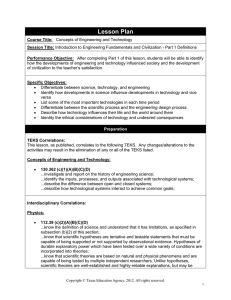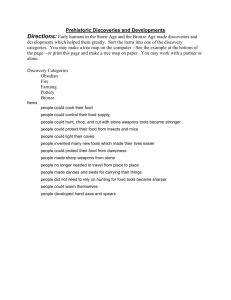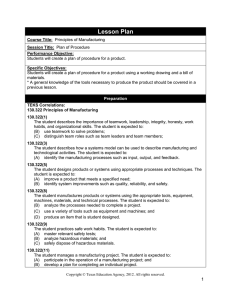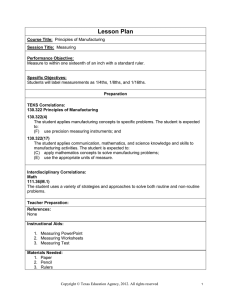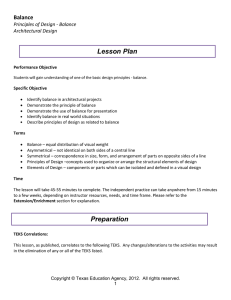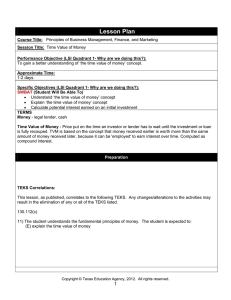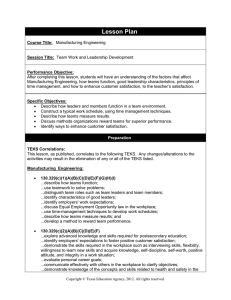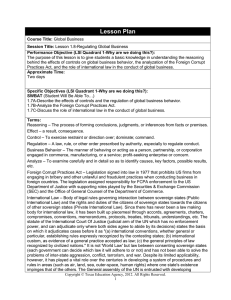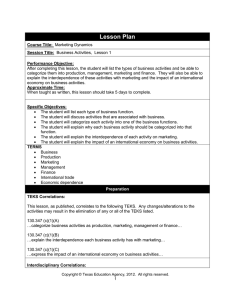Lesson Plan
advertisement
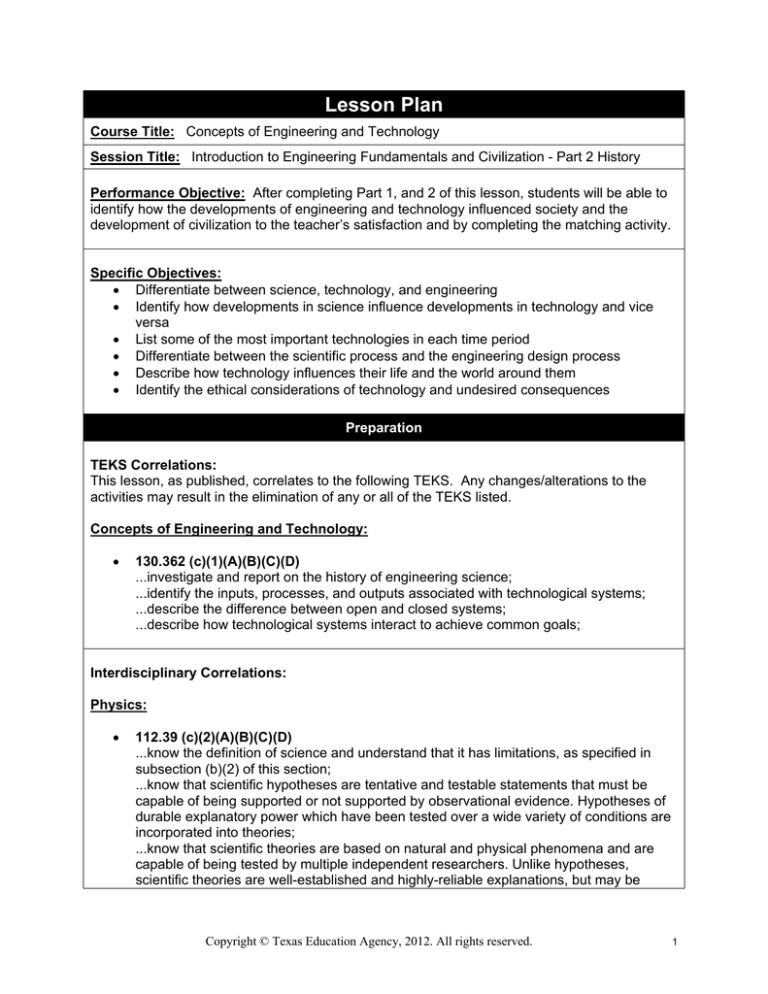
Lesson Plan Course Title: Concepts of Engineering and Technology Session Title: Introduction to Engineering Fundamentals and Civilization - Part 2 History Performance Objective: After completing Part 1, and 2 of this lesson, students will be able to identify how the developments of engineering and technology influenced society and the development of civilization to the teacher’s satisfaction and by completing the matching activity. Specific Objectives: Differentiate between science, technology, and engineering Identify how developments in science influence developments in technology and vice versa List some of the most important technologies in each time period Differentiate between the scientific process and the engineering design process Describe how technology influences their life and the world around them Identify the ethical considerations of technology and undesired consequences Preparation TEKS Correlations: This lesson, as published, correlates to the following TEKS. Any changes/alterations to the activities may result in the elimination of any or all of the TEKS listed. Concepts of Engineering and Technology: 130.362 (c)(1)(A)(B)(C)(D) ...investigate and report on the history of engineering science; ...identify the inputs, processes, and outputs associated with technological systems; ...describe the difference between open and closed systems; ...describe how technological systems interact to achieve common goals; Interdisciplinary Correlations: Physics: 112.39 (c)(2)(A)(B)(C)(D) ...know the definition of science and understand that it has limitations, as specified in subsection (b)(2) of this section; ...know that scientific hypotheses are tentative and testable statements that must be capable of being supported or not supported by observational evidence. Hypotheses of durable explanatory power which have been tested over a wide variety of conditions are incorporated into theories; ...know that scientific theories are based on natural and physical phenomena and are capable of being tested by multiple independent researchers. Unlike hypotheses, scientific theories are well-established and highly-reliable explanations, but may be Copyright © Texas Education Agency, 2012. All rights reserved. 1 subject to change as new areas of science and new technologies are developed; ...distinguish between scientific hypotheses and scientific theories; 112.39 (c)(3)(D) ...explain the impacts of the scientific contributions of a variety of historical and contemporary scientists on scientific thought and society; English: 110.42(b)(6)(A)(B) …expand vocabulary through wide reading, listening, and discussing; …rely on context to determine meanings of words and phrases such as figurative language, idioms, multiple meaning words, and technical vocabulary; 110.42(b)(7)(A)(I)(J) …establish a purpose for reading such as to discover, interpret, and enjoy; …use study strategies such as skimming and scanning, note taking, outlining, and using study-guide questions to better understand texts; …read silently with comprehension for a sustained period of time; Teacher Preparation: Introduction to Engineering Fundamentals and Civilization is a 3-part lesson. Teachers should review Part 1 Definitions; Part 2 History; and Part 3 Technology and all supporting documents such as PowerPoint presentations and notes; Definitions handout; Matching Activity handout; and Quiz to be prepared to deliver all 3 parts of this lesson. References: Hacker, et al. (2010). Engineering and Technology, 1st ed. Delmar, Cengage Learning. Karsnitz, O’Brian, Hutchinson. (2008). Engineering Design: An Introduction, 1st ed. Delmar, Cengage Learning. Gomez, Oakes, Leone. (2010). Engineering Your Future, 2nd ed. Great Lakes Press. Rogers, Wright, Yates. (2010). Gateway To Engineering, 1st ed. Delmar Cengage Learning. Wikipedia Other references as noted Instructional Aids: 1. PowerPoint presentation - Part 2 2. PowerPoint notes – Part 2 3. Matching Activity handout 4. Matching Activity key Materials Needed: 1. Pen or pencil 2. Simple examples of technology, like a spoon 3. A book Copyright © Texas Education Agency, 2012. All rights reserved. 2 Equipment Needed: 1. Computer 2. Overhead projector Learner Preparation: Have students research the history of technology using Wikipedia. Introduction Introduction (LSI Quadrant I): SAY: We are now going to learn about the history of engineering and technology. ASK: Does anyone know when technology development began? SHOW: Something simple like a desk or a pencil. SAY: Is this an example of technology? ASK: When do you think this was developed? Was this a major development of its time? SHOW: Students a book. ASK: Is the ability to create this new or old? How did the development of the ability to publish books change society? Outline Outline (LSI Quadrant II): Instructors can use the PowerPoint presentation, slides, handouts, and note pages in conjunction with the following outline. MI Outline Notes to Instructor I. The first slide is about Gordon Moore. A. The major point here is to get students to think about the rate of technology development. B. Throughout our history, technology development has been slow. C. It took thousands of years for some developments to become widespread (writing, agriculture), hundreds for others. Begin PPT slide presentation. One of the major points is for students to view technology differently. From a historical perspective, development was slow, humans had time to acclimate. Slides 1-2 II. Wants vs. needs A. This provides a general framework to categorize technology development. B. What want or need does it satisfy? C. When did technology development change from satisfying needs to satisfying wants? Many things we take for granted now were major developments that significantly improved life at the time. Slide 3 Copyright © Texas Education Agency, 2012. All rights reserved. 3 . III. Stone Age A. Simple developments B. Many years to spreads, become common. C. Fire, writing, the wheel How did some of the early developments lead to some of the basic elements of society like villages and communities? Slides 4-6 IV. Bronze Age A. Agriculture and the ability to feed large numbers of people lead to cities B. Cities and large numbers of people created a need for order, leading to religion and government C. Many of the centers of civilization are unfamiliar to students (Mesopotamia, Eurasia, China, and the Indus Valley) Religion may be a touchy subject, approach it with caution. However, order and the sense of community comes from shared values and cultures. Slides 7-9 V. The Iron Age A. The emergence of cultures we associate with: the Romans and the Greeks B. The first use of iron was in weaponry, but iron plows allowed the tilling of heavier soils C. Ox drawn plows and wheeled vehicles were other major agricultural innovations Slides 10-13 VI. The Middle Ages A. Very slow transformation of culture B. Feudalism, which is where a very large number of small and culturally diverse states and societies were dominant C. Christianity became the dominant religion in Europe D. Fragile central authority repeatedly damaged by invasions E. Agricultural based economic system Slides 14-15 VII. The Renaissance A. Revival of learning based on gradual but Slides 16-17 Copyright © Texas Education Agency, 2012. All rights reserved. 4 widespread educational reforms B. The printing press allowed rapid spread of new ideas C. A revival of scholarship, art, and literature D. The scientific method was a significant development, creating a systematic process for discovery VIII. The Industrial Revolution A. Enormous increase in productivity driven by the introduction of machinery and factory organization B. Manufacturing went from the home and the workshop to the factory C. Power driven machines replaced human and animal power D. Change from rural and agricultural society to urban and industrial E. Overcrowded and unsanitary living coupled with terrible working conditions Slides 18-19 IX. Negative effects of technology A. Students need to understand that even as the quality of life improves over time, increased sophistication of technology leads to greater environmental consequences. Verbal Linguistic Logical Mathematical Visual Spatial Musical Rhythmic Bodily Kinesthetic Intrapersonal Interpersonal Naturalist Existentialist Application Guided Practice (LSI Quadrant III): Students may pair-share to review the terms on Definitions handout. Independent Practice (LSI Quadrant III): Students will complete Matching Activity to match definitions and categorize the different technology developments from each age according to which need or want it satisfies. Use Maslow (or not). Summary Copyright © Texas Education Agency, 2012. All rights reserved. 5 Review (LSI Quadrants I and IV): Question: How does engineering from the Stone Age differ from what we think of as engineering now? Answer: Back then, control of fire and domestication of animals were engineering processes, but in our age of cell phones and computers, we would not consider them that way. Question: List the most important technology developments from each era. Answer: Any, as long as they defend their answer. Question: How did these technological developments change or influence society? Answer: Answers have to make sense in the context of the times. Evaluation Informal Assessment (LSI Quadrant III): Oral question/answer, pair/share on particular technologies, classroom participation and review of definitions. Formal Assessment (LSI Quadrant III, IV): Matching Activity and/or a research paper over the most important technologies of a particular era. Extension Extension/Enrichment (LSI Quadrant IV): Give students a variety of options on research papers: pair/share, PowerPoint, videos, oral presentations. Copyright © Texas Education Agency, 2012. All rights reserved. 6 Introduction to Engineering Fundamentals and Civilization – Part 2 Matching Activity Match the word or phrase on the left with its definition on the right. Invention limitation or restriction Constraint the practical application of science to commerce or industry Model a new way of doing something, an improvement on an existing form Artifact a simplified representation of a system or phenomenon, as in the sciences or economics Innovation a new, useful process, machine, improvement, etc., that did not exist previously Technology an object produced or shaped by human craft Copyright © Texas Education Agency, 2012. All rights reserved. 7 Match the invention or innovation on the left with the time era in which it was produced on the right. The grinding stone Stone Age Metalwork Plague and famine Bronze Age Forming and shaping The theory of universal gravitation Iron Age Air conditioning Domestication of animals Middle Ages Governments Sailing ships Renaissance Division of labor Mills and foundries Industrial revolution The printing press The steam engine Twentieth century Copyright © Texas Education Agency, 2012. All rights reserved. 8 Introduction to Engineering Fundamentals and Civilization – Part 2 Matching Activity Key Match the word or phrase on the left with its definition on the right. Invention limitation or restriction Constraint the practical application of science to commerce or industry Model a new way of doing something, an improvement on an existing form Artifact a simplified representation of a system or phenomenon, as in the sciences or economics Innovation a new, useful process, machine, improvement, etc., that did not exist previously Technology an object produced or shaped by human craft Copyright © Texas Education Agency, 2012. All rights reserved. 9 Match the invention or innovation on the left with the time era in which it was produced on the right. The grinding stone Stone Age Metalwork Bronze Age Plague and famine Middle Ages Forming and shaping Iron Age The theory of universal gravitation Renaissance Air conditioning Twentieth Century Domestication of animals Stone Age Governments Bronze Age Sailing ships Middle Ages Division of labor Bronze Age Mills and foundries Middle Ages The printing press Renaissance The steam engine Industrial Revolution Copyright © Texas Education Agency, 2012. All rights reserved. 10
